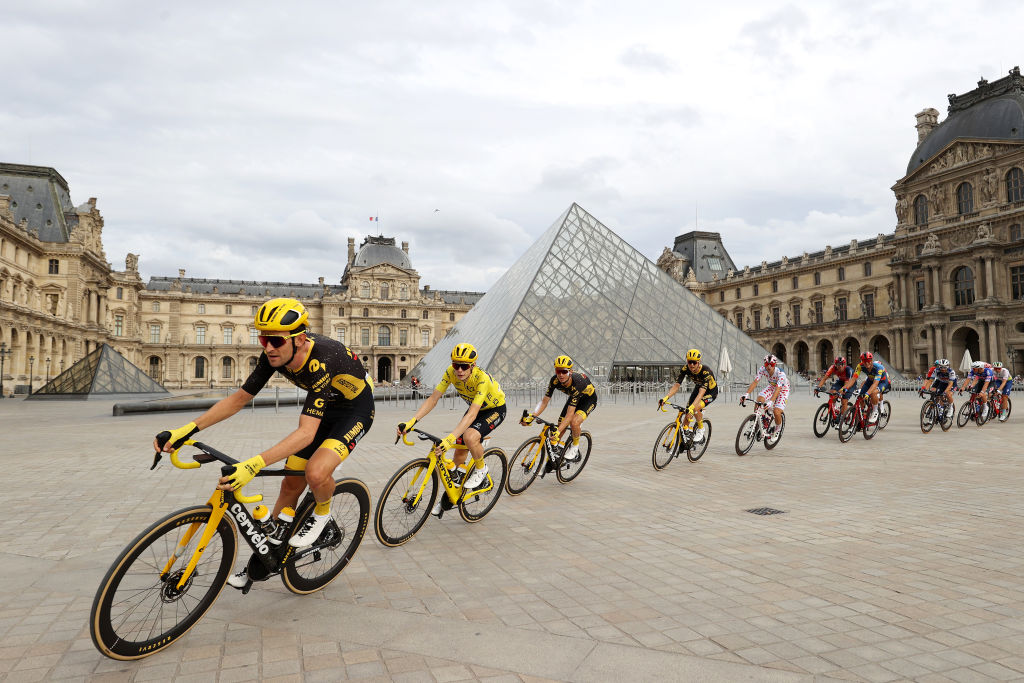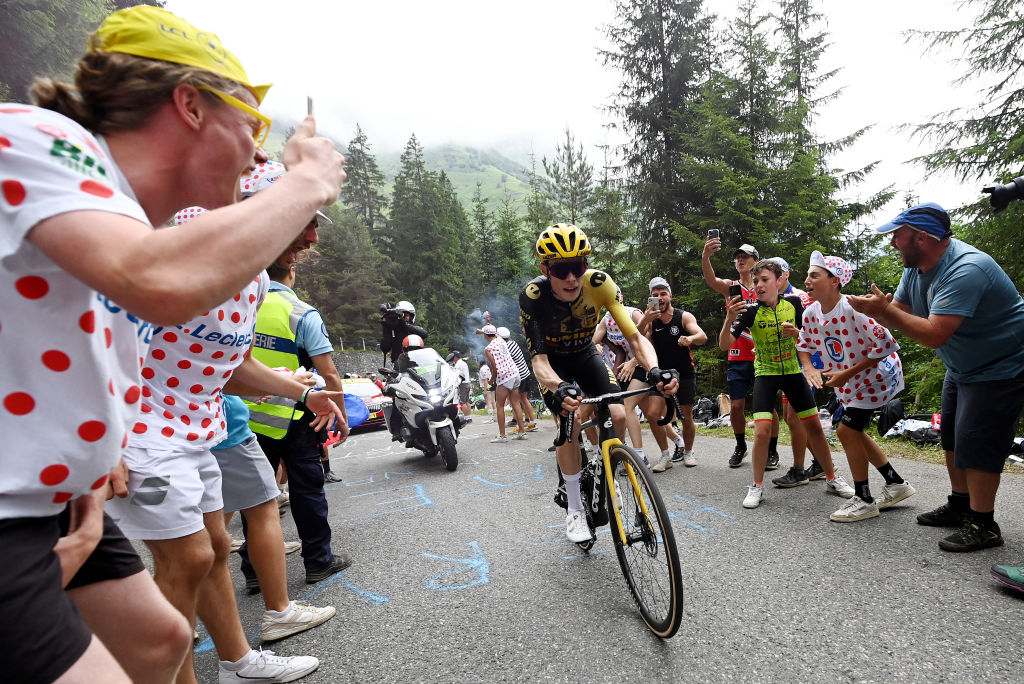“Imagine that the Tour de France winner was coming home from one hour riding a bike on the flat part in Denmark, and being very tired after that one hour, you can imagine he was very far away.”
That was how Visma-Lease a Bike lead sports director Merijn Zeeman described one of the multiple memorable points on Jonas Vingegaard’s rollercoaster pathway from what Zeeman called the “worst crash he had in his career” in April, to Thursday’s announcement, two months later he will take part in the Tour de France.
“But,” Zeeman added, “this guy is so incredibly talented that if he trains one hour, then the day after, he’s already better. And then he’s training two hours, and the day after, he’s getting better.
“That’s actually his natural talent and that’s why he’s in very good shape going into the Tour.”
However, Vingegaard’s terrible injuries from the Itzulia Basque Country mass crash on April 4 included broken ribs, a broken collarbone and a punctured lung, raising considerable doubts for many weeks as to whether he could be back racing in time for the Tour.
But on Thursday morning, it was confirmed that both Vingegaard and Wout van Aert, also badly injured this spring, would both be on the startline for Visma-Lease a Bike in Firenze on June 29.
In a lengthy and sometimes emotional interview on Thursday afternoon with a small group of media, Zeeman explained the complex but clear lines of argument that brought the riders and Visma-Lease a Bike to the decision they could take part.
The latest race content, interviews, features, reviews and expert buying guides, direct to your inbox!
It was a decision that only became definitive, in Vingegaard’s case, as recently as last Tuesday, and one which visibly – for Zeeman at least – produced a mixture of delight, boosted motivation and not a little pride in his riders, too. Just seeing them on the Tour de France startline, as he put it, will “already be a victory.”

‘Is he going to win the Tour?’
But with the decision looking increasingly likely over the last few days, the final confirmation was perhaps not so much of a surprise as it could have been. Certainly, the media’s attention is already switching unsettlingly fast from Vingegaard’s comeback to Vingegaard’s potential achievements, with one journalist asking Zeeman point-blank during the interview – “Is he going to win the Tour?”
“That’s the most difficult question to answer,” Zeeman replied. “I think he is among a group of riders that can win the Tour de France.”
Throughout the entire recovery process, Zeeman said, it was always up to Vingegaard to have the final say about whether or not he was going to go.
“I asked Jonas that question last Tuesday – what do you want? We believe that you are physically capable of winning the Tour de France and being competitive, but you have the last word. It’s your call.
“And he was very convinced that he wants to go.”
Zeeman recognised that the build-up had been radically different, though, with several consequences. Indeed, even before it became public the Danish star was doing the Tour, an original idea touted by Visma that Vingegaard “would have to be at 100%” to take part had subsumed into a much vaguer idea that Vingegaard would be at the Tour if he was “competitive.”
Zeeman explained the switch in the level of the bar for Vingegaard’s participation by saying that, “What I meant was that [without the crash] Jonas would have had a traditional preparation, with Basque Country, some recons, a first altitude camp at Sierra Nevada, the Dauphiné, then continuing at altitude.
“Following that path, we know that he can reach an incredibly high level and be the favourite for the Tour.
“But during the process [of recovery from the crash], it became clear that that was not possible, and going to Sierra Nevada and doing the Dauphiné would have been too soon. So that means he [still] lacks some race rhythm to reach his highest level.”
Yet if the usual build-up was not possible, Zeeman said, the alternative route taken by Vingegaard towards the Tour still showed more than encouraging signs.
“The preparation continued, and week by week, as his coach Tim Heemskerk updated me about the level it’d be possible to reach, we analysed that progression. It came to a point that he wouldn’t follow the traditional path, and there was no guarantee he’d be at a very high level. But he was very fit.
“And he is [very fit], as well as being very healthy, very motivated and really, really eager to race in the Tour de France.”
Extraordinary situations call for extraordinary solutions, and Zeeman described Vingegaard’s fightback from injury and “the worst crash of his career” as being a question of the rider “giving 100% every day. Day by day, doing the maximum.”
“In a traditional buildup, not every day is the most important, but in a rehab like he was, every day has to be 100%. I’m also very proud of that that he committed to it even when he was in the hospital in Vitoria.”
“He was so eager to already be as good as possible in the Tour de France. For us, already, that’s a victory, and that’s also true for Wout van Aert. We’re incredibly proud of them.”

All the way to Nice
During the two-month recovery process, as for whether there was a single day if it became clear that Vingegaard would be ok for the Tour, Zeeman said, “That’s a good question. It was a process.”
“If you analyse it week by week, at the beginning, it was very hard to believe that if he was so injured and you’re already tired after one hour of riding your bike that two months later, the same rider is ready to go for it in the Tour.
“But Tour de France winners are, let’s say, freaks of nature. They progress incredibly and we could not have imagined that he would have come to this point.
“And that’s why we came to the conclusion that he had to go to the Tour.”
And now? There is no guarantee, Zeeman said, that Vingegaard would be able to fight for yellow, but “he is ready to race.” As for what is possible, “We are a little in the dark. But he’s definitely good enough to take the challenge.
“We’re going to the Tour de France with a little bit of a different mindset. Last year, we felt the pressure as defending champions, while now we feel especially motivated to show who we are and leave all the bad luck behind us.
“There’s no pressure on us like ‘we need to win and anything less a disappointment.’ It’s already a victory that we got these guys on this level, that we are competitive, we have a great team and that we are very optimistic. If it’s good enough – we’ll see.”
Zeeman said that Vingegaard was currently “the only rider in our team at this moment who can win the Tour de France” – brushing aside the idea of a co-leadership, at least for now, with teammates Matteo Jorgenson, second in the Critérium du Dauphiné, or Vuelta a España winner Sepp Kuss.
However, he also admitted Visma-Lease a Bike are under no illusions that a freshly recovered Vingegaard will be receiving any kind of ‘grace period’ from his rivals once actual racing begins.
“I got in touch with Matxin [UAE Team Emirates lead sports director – ed.] and I said – ‘Hey, can we take it easy the first weekend, we’ve had enough bad luck.’ He agreed, so the break will win,” Zeeman said with a sardonic grin.
“No, no – it’s clear that it will be full throttle from the first stage, and we have to be ready for that. I believe we have a very good team, and I have great confidence in Jonas. But the first week will be hard.”
But even if it turns out, Zeeman said, that arch-rival Tadej Pogacar (UAE Team Emirates) is very strong in the first weekend in Italy and gains time, “That doesn’t mean that we will stop fighting.”
“We will do that until we are in Nice, on the last metre of the Tour. And then we will see where we are.”
Get unlimited access to all of our coverage of the Tour de France – including journalists reporting, breaking news and analysis on the ground from every stage of the race as it happens and more. Find out more.

